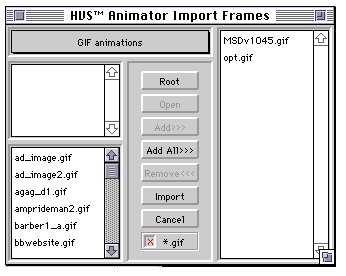
To open an existing single or multiple-image GIF file, click the "Open" button in the main window and select a file from the standard open dialog which appears. The frame(s) in the GIF file will replace any frames which are currently in the editor. If you currently have work in the editor which has not been saved, a dialog will automatically appear allowing you save your work, discard your work, or cancel the open action.
As of this writing, there is no similar drag and drop support available to Java on other platforms. As these features become available to Java applications on Windows and Unix, they will become part of the HVS Animator feature set. Maintenance releases are available to current users on the Digital Frontiers website, http://www.digfrontiers.com.

(Macintosh) To import all frames from a GIF file into the current animation, click the "Import" button in the main window and an Import dialog will appear. Select one or more files to import by selecting each filename, and click "Add" to add the selected file(s) to the import list. When you are done adding files, click Import and the frame(s) in these file(s) will appear in the current animation in the order in which they appear in the import list immediately after the currently selected frame.
(Windows) Windows users will see a standard file open dialog upon choosing Import. You can select multiple files in the list box and then hit the Open button to import them.
Mac users can also import a file by dragging it onto the HVS Animator icon while the application is running.
The Remove button removes GIFs from the add list. Add All is useful if you've created a directory containing only frames for a single animation, ordered alphabetically. The file list automatically sorts GIFs in alpha order, so you can easily create an ordered list of frames by using a naming sequence (for example, FRAME001.GIF, FRAME002.GIF, etc.).
For a step-by-step description of importing frames, see the Quick Guide section.
All frames that you import should share a common palette. If you import frames with a different palette, they will be assigned a local palette, which can cause rendering problems unless you specifically know what you're doing and intend that result. If you import a frame into frame 0 (the first frame in the animation), that frame's palette will become the global palette for the entire animation.
The current version of HVS Animator defers advanced color handling to its companion product, HVS ColorGIF 2.0. HVS Animator does have its own version of ColorGIF's HVS fixed palette reduction algorithm, which allows you to make more efficient use of color with existing GIF animations. The entire HVS ColorGIF manual is included in this release of HVS Animator.
We suggest that you use ColorGIF to generate your frames as single-image GIFs all sharing a common HVS MultiPalette. This will ensure that your animation frames will have the best quality at a minimum color count, and therefore the smallest size. For more detailed information on using ColorGIF with Animator to create stunning GIF animations, see Using HVS Animator with HVS ColorGIF 2.0.
